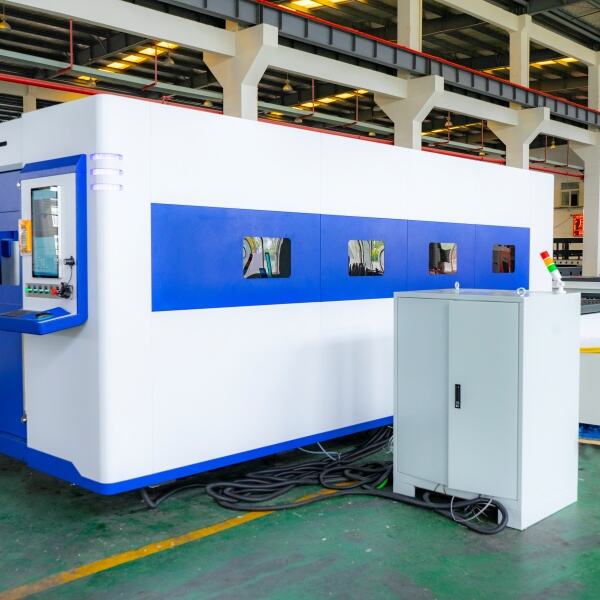مهمات الصيانة الأساسية لرؤوس القطع بالليزر الليفي
إجراءات التنظيف والتفتيش اليومية
ولتمديد عمر ماكينة القطع الليفية وتحقيق جودة قطع أفضل، يجب اتباع بعض الطرق، ومن ضمنها الصيانة اليومية. ابدأ بفحص رأس القطع بصريًا، وتحقق مما إذا كان هناك أي تآكل أو تلف مرئي – تأكد من فحص العدسات والمرايا بحثًا عن أي أوساخ أو حطام. يجب تنظيف هذه العناصر البصرية برفق (باستخدام مواد التنظيف المناسبة) وتجنب تمامًا استخدام قماش خشن لمنع الخدوش. بالإضافة إلى ذلك، من المهم تسجيل الملاحظات أثناء كل عملية تفتيش. تتيح هذه الوثائق تتبع التكرارات وتعديل استراتيجيات الصيانة حسب الحاجة، مما يؤدي إلى تحسين استقرار الأداء المستمر للماكينة.
فحوصات نظام المبرد الأسبوعية
يحتاج نظام المبرد في ماكينة قطع الليزر بالألياف إلى مراجعة أسبوعية لضمان استمرار تشغيل المعدات بمستوى الأداء الأمثل. أولاً، يمكنك التحقق من تشغيل المبرد، والتأكد من أن درجة حرارة سائل التبريد مستقرة وصالحة. ويشمل ذلك فحص سائل التبريد: إعادة ملئه إذا كان منخفضاً، والبحث عن أي تسرب قد يعيق تشغيل الماكينة. كما من المهم تقييم نظافة ملفات المبرد وفلاتره، وتنظيفها عند الحاجة. عندما يُحافظ على كفاءة نظام التبريد، فإن خطر ارتفاع درجة حرارته يقل بشكل ملحوظ، ويزداد موثوقية تشغيل الماكينة.
الصيانة الشهرية للفوهة والعدسة
يجب الحفاظ على الفوهة والعدسة بشكل شهري لضمان جودة القطع الطبيعية والدقة في ماكينات القطع بالليزر الليفي. قم أولاً بفحص الفوهات والعدسات بالكامل للبحث عن أي شيء قد يؤثر على الأداء، سواء كان ذلك بسبب البلى أو بسبب تأثير دورة الحرارة التي تؤدي إلى فقدان المغناطيسية. استخدم إجراء تنظيف متخصص مع سوائل تنظيف متوافقة مع العدسات والفوهات. يضمن ذلك أن تكون هذه الأجزاء في ذروة كفاءتها. بالإضافة إلى ذلك، إذا كانت أي قطعة مهترئة، يمكنك استبدالها قبل أن تواجه مشكلة في الإنتاج وبالتالي تضمن الحصول على منتج جيد طوال الوقت. مع الاعتناء بصيانة هذه الأجزاء، ستواصل ماكينتك تقديم قطع نظيف ودقيق في كل مرة.
تحسين أداء رأس القطع في الظروف القاسية
أداء ماكينات القطع بالليزر الليفي في الطقس البارد للغاية، مع الظروف الجوية القاسية، يحتاج مشغل ماكينات القطع بالليزر الليفي إلى تشكيل نظام لضمان إجراء عمليات القطع بشكل آمن وكفاءة. يُعد تقلب درجة الحرارة مؤشرًا على مدى جودة إدارة درجة الحرارة العاملة، حيث أن تقلبات درجة الحرارة تؤثر على أداء الليزر وجودة القطع. ولمنع ذلك، استخدم فقط مستشعر درجة الحرارة لإدارة الحرارة أثناء الاستخدام. يجب عزل المكونات الحساسة لحمايتها من درجات الحرارة الخارجية الشديدة. بل قد يُضطر إلى تغيير البروتوكولات التشغيلية بناءً على الظروف البيئية. يمكن أن يكون ذلك مثلًا سرعات قطع مختلفة لدرجات حرارة مختلفة للحفاظ على ثبات قدرة القطع بالليزر.
الرطوبة مهمة بنفس القدر في منع التلف الذي قد يصيب معداتك. فيما يلي بعض الطرق التي يمكنك من خلالها تجنب التكاثف في المناطق الرطبة: التحكم في الرطوبة داخل منطقة القطع يمكن تحقيقه من خلال تركيب أجهزة إزالة الرطوبة أو مكيفات الهواء. كذلك من المهم تغليف أي مكون إلكتروني داخل غلاف مقاوم للماء لمنع التلف الناتج عن الرطوبة. يجب أن يحمي هذا الغلاف النقاط الحيوية من دخول الماء إليها، ولكن من الأفضل فحص الختمات والواقيات بشكل دوري. إن هذه الاستراتيجية الوقائية تُعد أساس إدارة الرطوبة والمفتاح لحماية عمر المعدات.
إن روتين وجدوى جداول الصيانة محل شك في فصل الصيف. نصائح صيانة لفصل الصيف: إن النصائح العامة لصيانة أوقات الصيف تُطبَّق بشكل أفضل من خلال فحص أنظمة التبريد كل شهر إلى شهرين. يجب تنظيف مبادل الحرارة وأنظمة التبريد بطريقة التنظيف الأمامي FORWARD CLEANING! مما يسمح بتشغيل أمثل حتى مع الأحمال الحرارية العالية. يجب تدريب المشغلين على التعرف على علامات ارتفاع درجة الحرارة والتنفيذ السريع للإجراءات الطارئة، والتي يجب أن تكون جزءًا من العناية برأس القطع. إن الصيانة المنتظمة في فصل الصيف لا تساعد فقط في الحفاظ على أداء المعدات، بل أيضًا في إطالة عمر المعدات خلال الظروف الموسمية الصعبة.
تشخيص وحل مشاكل رأس القطع الشائعة
معالجة تدهور جودة الشعاع
يمكن أن يؤدي انخفاض جودة الشعاع إلى التأثير على أداء ونوعية القطع. الخطوة الأولى هي ملاحظة التحذيرات مثل فقدان التركيز أو تراكم الرواسب الزائدة على الشقوق. يمكن أن تُعزى هذه المشاكل إلى عدسات أو مرايا مخدوشة أو متسخة، لذا فإن فحص العدسات والمرايا أمر أساسي. كما يمكن أن يساعد استبدال الأجزاء التالفة في استعادة الأداء إلى حالة جيدة. بالإضافة إلى ذلك، فإن تحسين معايير عملية الليزر، مثل موقع التركيز والطاقة، سيساهم في تحسين كفاءة القطع. إن التحسين المنتظم والتعديلات المتكررة ضروريان لمراقبة الشعاع.
حل مشاكل محاذاة الفوهة
يتطلب القطع الدقيق ضبط فوهة القطع بدقة. يؤدي سوء التحالف إلى قطع سيئة، لذا من المهم جدًا استخدام أدوات محاذاة الليزر للتحقق من التحالف. يجب إجراء التعديلات وفقًا لتعليمات المصنّع، وتوثيقها، وحفظها كمرجع. من الضروري إعادة التحقق من المحاذاة كلما تم استبدال قطع جديدة أو إجراء تعديلات رئيسية على الجهاز للتأكد من الحفاظ على دقة القطع. يمكن أن تمنع الفحوصات والتعديلات الدورية سوء محاذاة الفوهة وتحافظ على جودة القطع العالية.
إصلاح عرض شق غير منتظم
سوف تؤدي عروض الشق غير المنتظمة إلى جودة سيئة ودقة القطع. من الضروري أن تقوم بتشخيص هذه المشكلة وأن تحدد نتائج القطع على عدة مواد مختلفة! يجب في هذا الوقت التحقق من أي مشتبه بهم مثل فوهات مستهلكة أو إعدادات تركيز خاطئة واتخاذ الإجراءات اللازمة. يمكن لهذا النوع من الاختبار على نوع معين من المواد أن يساعد في تعديل إعدادات عرض الشق. وبتحديد مصدر عدم الانتظام وتصحيحه، يمكننا ضبط عملياتنا لتحقيق قطع متسق وعالٍ الجودة. كما أن إعادة الاختبار والمحاذاة الدورية ضرورية للحفاظ على دقة القطع على أعلى مستوى.
تقنيات الصيانة المتقدمة لضمان الموثوقية على المدى الطويل
استراتيجيات التزييت للمكونات المتحركة
يعد التشحيم ضروريًا لتقليل البلى والتآكل على الأجزاء المتحركة في الآلات. من المهم اتباع روتين صيانة للتشحيم يعتمد على مواصفات الشركة المصنعة للمعدات (OEM). هذا يضمن حركة سلسة لجميع الأجزاء ويقلل من الاحتكاك والبلى. أقترح اختيار منتجات تشحيم مصنفة لتحمل درجات الحرارة العالية وتقليل البلى على الأجزاء الرئيسية. كما أنه من المفيد وجود نظام لتتبع عمليات التشحيم، فهذا لا يساعد فقط في إنشاء نمط للصيانة، بل يمكن أيضًا أن يساعد في اكتشاف أنماط قد تشير إلى مشكلة كامنة، مما يسمح بحل المشكلات مسبقًا.
مراقبة جودة سائل التبريد
يتم أيضًا مراقبة جودة سائل التبريد. قد تكون الفحوصات الدورية لاختبار الرقم الهيدروجيني والتوصيلية مفيدة لاكتشاف مشاكل سائل التبريد مبكرًا، والتي قد تؤدي في غير ذلك إلى التآكل أو تدهور المكونات الأخرى. تسجيل تغييرات سائل التبريد ومعالجاته يسمح بمتابعة الأداء على مر الزمن ويصبح من الممكن ملاحظة الاتجاهات. من خلال الاحتفاظ بهذه السجلات، يصبح من المرجح اتخاذ قرار مدروس بشأن توقيت تغيير سائل التبريد ومعدله، مما يمكن أن يؤدي في النهاية إلى قطع أكثر فعالية وعمر أطول للمكونات الآلية.
جداول الاستبدال الوقائي
وبالإضافة إلى ذلك، فإن برنامج الصيانة الوقائية الجيد يلعب دوراً محورياً في التنبؤ بوقت فشل أجزاء معينة بناءً على الزمن والاستخدام. ويمكن تنفيذ عمليات الاستبدال التنبؤية بسلاسة بمساعدة تحليل البيانات. من خلال دراسة الاتجاهات الخاصة بالاستخدام ومراجعة سجلات الفحص والإصلاح، يمكنك التخطيط لتبديل المكونات الخاصة بك والحد من توقفات العمل غير المخطط لها. وعندما يدرك كامل الفريق فوائد الاستبدال الوقائي المتمثلة في القيام باستثمارات تمنع الأعطال بدلاً من التعامل معها بعد حدوثها، فسوف يلتزمون الجدول الزمني وستتماشى سلوكياتهم مع الاستجابة المقصودة، ألا وهي العقلية الوقائية التي تمكّن من تحقيق الموثوقية والكفاءة على المدى الطويل.
تأثير الصيانة السليمة على تكاليف التشغيل
تمديد عمر المكونات
الصيانة الجيدة تضاعف العمر المحتمل لمكونات الماكينة. من الضروري تقديم صيانة جيدة للمكونات لتعظيم عمرها الافتراضي. ستواصل الماكينات التي تتم صيانتها بانتظام العمل بكفاءة لفترة أطول. كما يعني ذلك أيضًا إجراء إصلاحات في الوقت المناسب واستبدال أجزاء المعدات لتجنب الأعطال المدمرة التي قد تؤدي إلى توقف الماكينة وتسببًا تكاليف باهظة. من خلال مراقبة وتحليل أرقام العمر الافتراضي، يستطيع المصنعون تبرير ميزانياتهم وتقنيات الصيانة، مما يؤكد أن كل دولار يتم ضخه في الماكينات الحديثة هو استثمار يوجه إلى صميم الماكينة لضمان مستقبلها الطويل والصحي.
تقليل استهلاك الطاقة
يمكن أن يؤثر صحة المعدات بشكل كبير على كمية الطاقة المستهلكة، حيث يمكن تقليل تكاليف الطاقة حتى 25٪ من خلال الحفاظ على صحة المعدات. ويرجع ذلك إلى أن المعدات التي تعمل بشكل مثالي تكون أكثر كفاءة وبالتالي تحتاج إلى طاقة أقل لإتمام نفس المهمة. تصل المعدات إلى سرعة القطع الأكثر كفاءة وتكون كافية للحفاظ على الأحمال الحرارية منخفضة عندما تكون نظيفة وعندما يتم صيانتها بشكل دوري. ويمكن للتحاليل الدورية للطاقة التحقق من كيفية تأثير ممارسات الصيانة على استهلاك الطاقة والتكاليف، كما أنها تساعد في تحديد الأمور التي تحتاج إلى مزيد من الانتباه والصيانة.
تقليل توقفات العمل غير المخطط لها
إن برنامج الصيانة الفعال ضروري لمنع توقف العمليات بشكل غير مخطط له، مما قد يكون مكلفًا، وفي بعض الحالات يصل تكلفته إلى آلاف الدولارات في الساعة. باستخدام طرق الصيانة التنبؤية، يمكن للشركات التنبؤ بالأعطال قبل حدوثها، وحماية خطوط إنتاجها والحفاظ على سير عملياتها بشكل منتظم. ويشمل تقليل وقت التوقف أيضًا بشكل متساوٍ تدريب الموظفين بشكل صحيح على ملاحظة علامات فشل المعدات. هذا هو نهج استباقي ليس فقط للحفاظ على استمرارية العمل، بل أيضًا كوسيلة أكثر فاعلية لتحقيق الإنتاجية والكفاءة.



